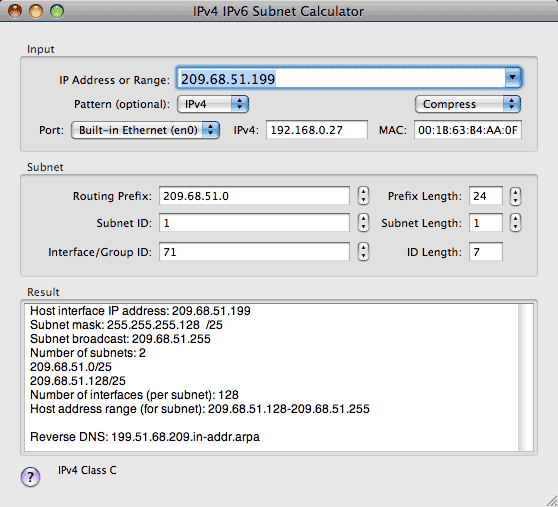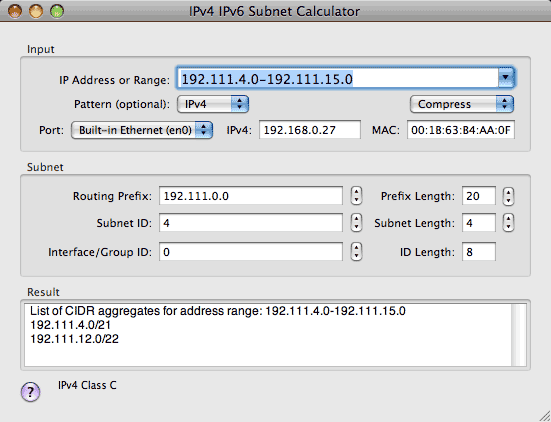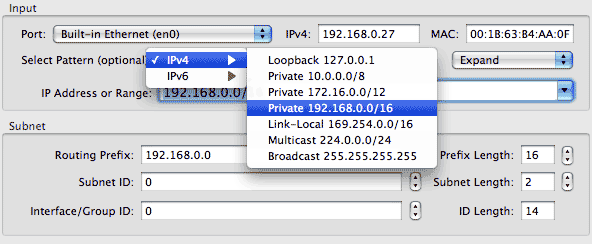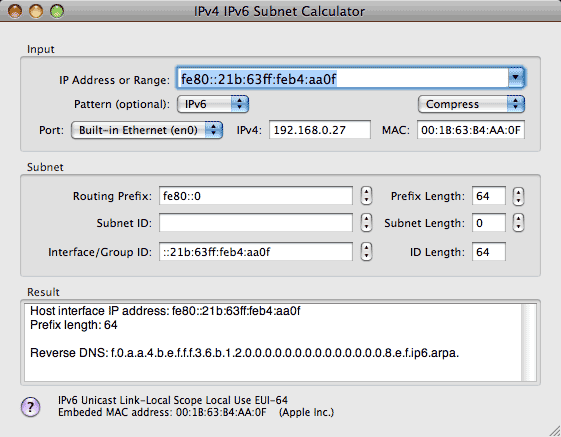

You can split an IP address into 3 parts (routing prefix, subnet, interface ID). The Interface ID was previously known as the "host number", but this is not as consistent since a host can have multiple interfaces. Enter a prefix length or subnet length in the Subnet area to split the address as desired.
View the results. As you adjust the prefix length, subnet length, or any part of the address, the results update accordingly.
The previous IPv4 Only Subnet Calculator is still available by pressing the Option key while selecting the Subnet Calculator tool from the tool menu or launcher palette.
The Subnet Calculator makes it easier to understand and specify IP addresses and masks or prefix lengths for routing. The Subnet Calculator shows the IP address category or pattern as a description along the bottom of the window below the Results box.
The Subnet box allows you to examine how an IP address is split between a Routing Prefix or network number, a Subnet number (if any), and a Host Interface number (or Group ID for multicast addresses). The length in bits and value of each portion can be adjusted separately. The prefix length can be entered with the IP Address explicitly (209.68.51.199/24), or if omitted, the subnet calculator will try to determine the prefix length based on the address entered.
The Subnet Calculator can determine the CIDR alignment based on the right most 1-bit in the network prefix if an address ends in "/" with no length specified. Entering "146.111.96/" for example will show the Routing Prefix as 146.111.96.0/19.
The Subnet Calcuator will list the subnets (if any) in the Results box along with the host address range and other information. The "Reverse DNS" string is used for address-to-name lookups or "Pointer" (PTR) queries to a name server.
The Subnet Calculator can list the CIDR aggregates for a range of IP addresses. Two IP addresses separated by a hyphen form an IP address range (example: 192.111.4.0-192.111.15.0).

The Subnet Calculator converts prefix lengths into corresponding dotted quad net masks. The host address range shown includes the first and last address of the range which are normally reserved for IPv4 subnet broadcasts and thus are not assigned to individual interfaces.
The Subnet Calculator will accept a decimal IP address as input and convert to a dotted quad. Entering "3232235521" will display IP address 192.168.0.1 for example. This can used to help track down spammers who disguise their IP address in decimal form.
The Subnet Calculator can help you to recognize and use common IP address patterns or categories using the "Pattern" popup menu.

The network "Port" popup menu allows you to see the currently configured IP address for the selected port if any.
The IPv6 Subnet Calculator extends the basic features above to cover 128-bit IPv6 addresses.
IPv6 addresses are often created from an underlying IPv4 or Ethernet MAC address and the Input box allows you enter these components directly or use the currently configured values from your system by selecting the corresponding network port.
The "Pattern" popup displays a list of common IPv6 address categories you can use to build a desired address, and the Description field along the bottom of the window identifies the category and sub components of any IPv6 address entered.


The Compress/Expand popup menu allows you to view IPv6 addresses in compresed or expanded form (including subnet information).

When you invoke one window from another, the corresponding data is automatically transferred.
A popup menu keeps a list of Recent Targets or history pre-loaded with some common values based on your network configuration. The contents of the target field are added to the list when a test to that target is invoked. If the recent targets menu becomes full (10 entries), the least recently used item will be removed. To add or remove an item, or clear the entire list, use the corresponding selections from the History menu.
You can open and use multiple Subnet Calculator windows at the same time.
The previous IPv4 Only Subnet Calculator is still available by pressing the Option key while selecting the Subnet Calculator tool from the tool menu or launcher palette.
